
TRUE NIGHTVISION (iOS)
Last updated: 8 February 2012
 True NightVision v2.0
True NightVision v2.0
$0.99
I received a "redeem code" for "True NightVision", an iOS camera app, from interealtime.com. Its features (from their web site) are:
4 powerful modes:
Features:
I was curious to see how well the app would work for astrophotography. I tested the app on an iPhone 4 with iOS 5.0.1. I first used the app indoors. When launched, you see this screen with a live view from the camera and the various controls:

The controls can be hidden by tapping the down arrow. Tapping the MODE button between the sliders, you can set some exposure options:
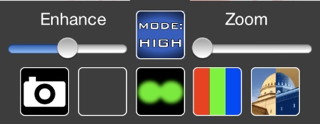

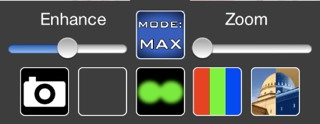
You can set some effects by tapping one of the three right-most buttons at the bottom:



Here are some example photos taken by True NightVision. These were taken in a darkened room, with only a TV screen providing illumination. The first one has been rotated to show the "binocular" effect.



I took this next photo of my observatory at night. The interior was illuminated by red lighting. The exterior was illuminated by a Full Moon.

For comparison, this photo was taken with the Apple Camera app:
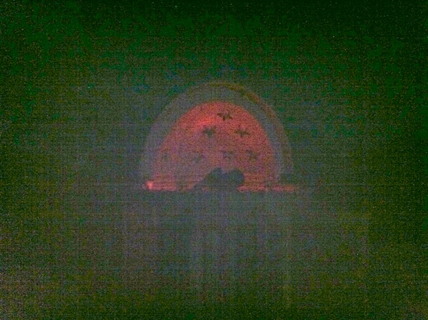
My impression of True NightVision at this point was that it is more a "fun app" that can show low-light scenes and capture those scenes in photos. But I still wanted to try it out for astrophotography and see how it compared to two other apps I have tried: Slow Shutter and Slow Shutter Cam.
After the waning moon was no longer a factor, I did some DSO test astrophotography using True NightVision. When doing long duration imaging at the telescope, you can't handhold the phone over the eyepiece due to the long exposure. As with the observatory photos above, which were taken with a tripod, I used the Magnilux MX-1 Afocal Adapter to hold the iPhone. Using afocal photography with a 26mm eyepiece + focal reducer on my 8" LX200-ACF telescope, I tested on True NightVision on two DSOs: the Double Cluster and M42, the Great Nebula in Orion. I edited the resulting images in Aperture; reduced the saturation to remove the color and adjusted the Luminence to reduce the vertical "noise" lines. While imaging, one thing surprised me: stars were easily seen on the True NightVision live screen, which allowed focusing the image. Here are two images of the Double Cluster. The top image had the "enhancement" slider to halfway and the bottom image had it full to the right. None of the other True NightVision effects were used, as they would be inappropriate for astrophotography.


While not all of the stars in the clusters can be seen, several stars are visible in the images.
This is M42 with the same Enhance slider adjustments:


Some nebulosity is just barely visible in both images.
On another session, I did more imaging of M42, this time without the focal reducer, so the magnification was 77X. I used each MODE setting: SPEED, HIGH, STILL, and MAX, to see how the setting differed when imaging a DSO. Here are each of the exposures, unedited, with the enhancement slider to mid and max positions, to show the differences:
MODE = SPEED, Enhance = mid
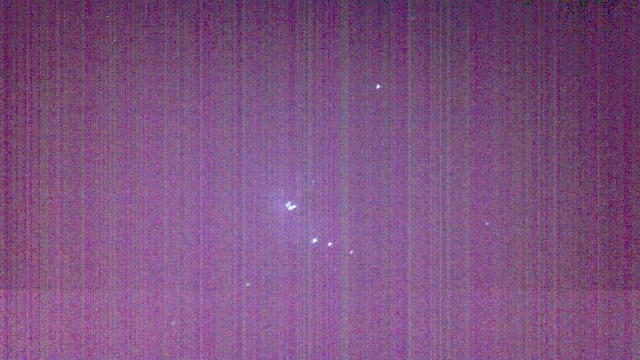
MODE = SPEED, Enhance = max

MODE = HIGH, Enhance = mid

MODE = HIGH, Enhance = max
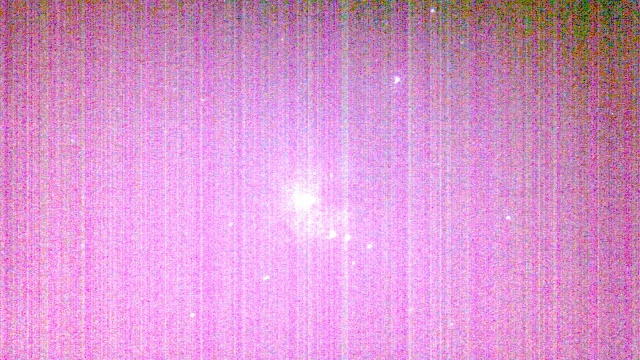
MODE = STILL, Enhance = mid

MODE = STILL, Enhance = max

MODE = MAX, Enhance = mid

MODE = MAX, Enhance = max

Obviously, the MODE = STILL with Enhance slider at the middle was the best exposure. I edited the image in Aperture, with this result:

This is the best image of M42, the Great Nebula in Orion, that I have captured using the iPhone. True NightVision made it possible.
Just for grins, I decided to take a handheld photo of the constellation of Orion, MODE = STILL, Enhance = mid. Orion appeared without requiring any editing, and with editing, this is the result:

Amazing for an iPhone.
I tested True NightVision on Earthshine on the moon. These are the unedited images:
MODE = NORM

MODE = FAST ACTION

MODE = STEADY MOTION

This is the MODE = STEADY MOTION image, edited in Aperture:

The standard iOS Camera app was not able to capture the Earthshine.
I look forward to trying more iPhone DSO images using True NightVision, as this is the first iOS app I have tried that can image some Deep Sky Objects. One point: I tried to use the iPhone earbuds as a remote shutter release, but it didn't work. This is a very useful feature of the Camera app, and I hope it can be added to True NightVision. Another good feature would be a configurable self-timer to allow vibrations to dampen out before the image is taken. Lastly, It would be nice if the app would remember the last used MODE setting (t always defaults to SPEED).
While True NightVision creates "noisy" images, it can capture stars, and so will be able to image many star clusters. Unfortunately, while it can capture bright DSOs like M42, it will not be usable on faint nebula due to limitations with the camera.
Check out my review of the developer's "NightCap" app to see how well it did when doing long duration (up to 1 second) astrophotography with an iPhone.
Go to the ETX site.
Go to the Cassiopeia Observatory site.